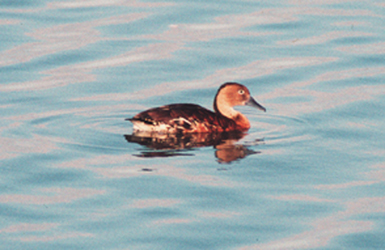| Fulvous Whistling-Duck
Dendrocygna bicolor Chiriría Amarillenta, |
 |
|
Photo: G. Beaton
|
| Fulvous Whistling-Duck
Dendrocygna bicolor Chiriría Amarillenta, |
 |
|
Photo: G. Beaton
|
|
IDENTIFICATION: A light brown duck with white at the base of the tail. Length: 45-53 cm.; weight: 621-755 g. VOICE: A hoarse whistle. HABITAT: Freshwater swamps and marshes, especially near foraging areas in tall grass and rice fields. HABITS: Like other whistling-ducks, this species is mostly nocturnal, but is more often found on the ground than perched in trees. It feeds in small flocks on fruits, bulbs, and seeds, especially rice. It gleans food off the ground, or dabbles in shallow water and sometimes dives for food. The female builds a nest in thick mounds of vegetation on the ground or occasionally in a tree cavity, although some females "dump" their eggs into the nest of another bird. The female lays 6-16 white or buff-colored eggs. Both sexes incubate over a period of 24-28 days. The chicks leave the nest soon after hatching and are guided to feeding areas by both parents. The chicks fledge at about 55-64 days. STATUS AND CONSERVATION: This rare species recently expanded its range onto some of the islands of the West Indies, including Puerto Rico. Since it is nocturnal and shy of humans, it is not easy to monitor its population status or distribution, so it may be more common than currently suspected. RANGE: The Fulvous Whistling-Duck has an unusual, mostly tropical distribution. It is found from the Gulf Coast of the USA, south through the West Indies to Ecuador and Argentina, and also in tropical Africa and South Asia. Formerly regular at Laguna Cartagena National Wildlife Refuge before water levels dropped there; rare at Caño Tiburones Nature Reserve. TAXONOMY: ANSERIFORMES; ANATIDAE; Dendrocygninae. Formerly called the Fulvous Tree Duck; also called Chiriría Achocolatada in Spanish. |
|
|
References Bent, A.C. 1923. Life histories of North American wild fowl, part 2. Smithsonian Instit. U.S. National Museum Bull. 126. (Reprinted by Dover Press, NY, 1962). del Hoyo, J., A. Elliott, and J. Sargatal, eds. 1992. Handbook of Birds of the World, Vol. 1. Ostrich to ducks. Lynx Edicions, Barcelona. Ehrlich, P.R., D.S. Dobkin, and D. Wheye. 1988. The birder’s handbook: a field guide to the natural history of North American birds. Simon and Schuster/Fireside, NY. Hohman, W. L. and S. A. Lee. 2001. Fulvous Whistling-Duck: (Dendrocygna bicolor). No. 562 in The Birds of North America (A. Poole and F. Gill, eds.). The Birds of North America, Inc., Philadelphia, PA. Madge, S. and H. Burn. 1988. Wildfowl: an identification guide to the ducks, geese, and swans of the world. C. Helm, London. Ortiz Rosas, P. 1981. Guía de cazador: aves de caza y especies protegidas. Depto. de Recursos Naturales, San Juan, PR. Raffaele, H.A. 1989. A guide to the birds of Puerto Rico and the Virgin Islands. Princeton. Raffaele, H.A. 1989. Una guía a las aves de Puerto Rico y las Islas Vírgenes. Publishing Resources, Inc., Santurce, PR. Raffaele, H.A., J.W. Wiley, O.H. Garrido, A.R. Keith, and J.I. Raffaele. 1998. Guide to the birds of the West Indies. Princeton. Fulvous Whistling-Duck, Spanish text Next related species in taxonomic order Previous related species in taxonomic order |
|